For a huge number of media publishers and brands uploading video content to Facebook, increasing the Watch Time of those videos has become one of the most important metrics to track. Fortunately, Facebook seems to have figured out what gets more eyeballs on your video content and has confirmed that 48% of watch time on Facebook videos comes directly from shares. That’s right – encouraging your Facebook followers to share your clips with their own followers is going to have a very positive knock-on effect for you.
Of course, there are a number of factors that brands and publishers need to take into consideration when it comes to engaging their target audience on Facebook (decent video production values, access to stellar audience insights, partnering with other influential Facebook properties to increase reach, creating innovative and appealing content etc.). But there is still a great deal that can be done to improve engagement on your videos which will boost your Watch Time ROI. Take a look at our actionable takeaways below:
15 Ways to Increase Facebook Video Watch Time
Here are 15 different ways you can encourage your viewers to share clips with their friends and family and therefore increase the average watch time on your video content:
1. Upload Your Videos Natively
While it seems intuitive, posting a video to Facebook via the site’s native uploader (instead of, for example, posting a link to a YouTube or Vimeo video) will encourage more engagement and organic shares. In fact, a 2017 study discovered Facebook videos on average receive a 477% higher share rate than the YouTube format. Additionally, native Facebook videos attract roughly 530% more comments than linked YouTube videos.
Some brands might feel that in order to save their content and social teams time, they can create one video and simply cross-post it on various social video platforms. Unfortunately, as the stat above proves, Facebook users are far less inclined to share a non-native Facebook video, which is counter-productive to your goal of getting more shares to increase your overall watch time. Essentially, cross-posting might save you time for the short term, but in exchange you’re giving up a lot of valuable engagements and shares in the long run.
2. Make Square or Vertical Videos
Even though we just looked at the importance of uploading natively to Facebook, you should actually take a cue from Instagram when it comes to the shape of your video content. Why? Facebook videos which are square, like they are on the site’s separate photo-sharing app, tend to get more shares, views, engagement, and reach (particularly on mobile), according to a Buffer study. In particular, Buffer found square videos take up about 78% more real estate space on a Facebook user’s phone than a landscape format, meaning these users are more likely to watch, share, and engage with the clips.
In addition to square videos, your brand can consider making vertical videos. Since early 2017, Facebook has been serving users larger vertical video previews in their feeds, as the site said it’s focused on improving the video viewing experience. This update implies more users are spending time watching vertical videos, so it may be worth it for your brand to experiment to see if this format increases your shares and engagements.
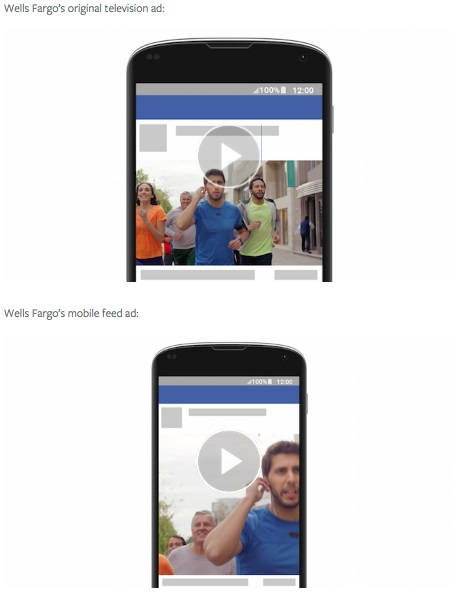
3. Create Shareable Videos
We noted in the introduction to this article how your first rule of business when creating videos for Facebook should be to create quality content. But if you combine this strategy with a compelling story or message, you’re sure to get more of a reaction from your viewers. For instance, your brand could support a cause or start a conversation around something your audience is passionate about. You could also focus on posting inspirational or funny human interest pieces related to your brand, as these types of videos continually attract millions of views per month (according to our monthly Facebook leaderboard results, at least).
We’re not the only ones who’ve noticed how well shareable content generates shares and engagement on Facebook. Content analytics company Buzzsumo looked at over 100 million videos on the social site and discovered videos with a humorous or uplifting tone tended to perform the best in terms of views, engagements, and shares. Another style of video to consider, according to Buzzsumo’s research, is hacks, tips, and how-to clips. Try out these types of videos to see which get the most reaction from your audience.
4. Optimize Introductions and Thumbnails
It’s no secret Facebook considers three seconds into a user watching a video as a view. So if you want to increase your watch time via engagement and shares, you have to give your audience a reason to keep watching past those first three seconds. It’s essential to jump right into the start of your videos with compelling images, camera angles, colors, and dialogue or text which address the heart of the message you’re trying to tell so your viewers are curious about the beginning. It’s especially important to pay attention to creating a great video even if a user’s individual sound setting is turned off for videos, despite Facebook’s default setting of auto-playing sound.
On a related note, you should also make sure your thumbnails for each of your videos pique the interest of your viewers. Optimizing your video content won’t matter if the first image they see before the video plays seems unrelated or — even worse — boring. Making a custom thumbnail for each of your brand’s videos will not only help ensure they capture the attention of users as they scroll through their feeds, but will also give you that much more possibility of those same users sharing your video with friends and family.
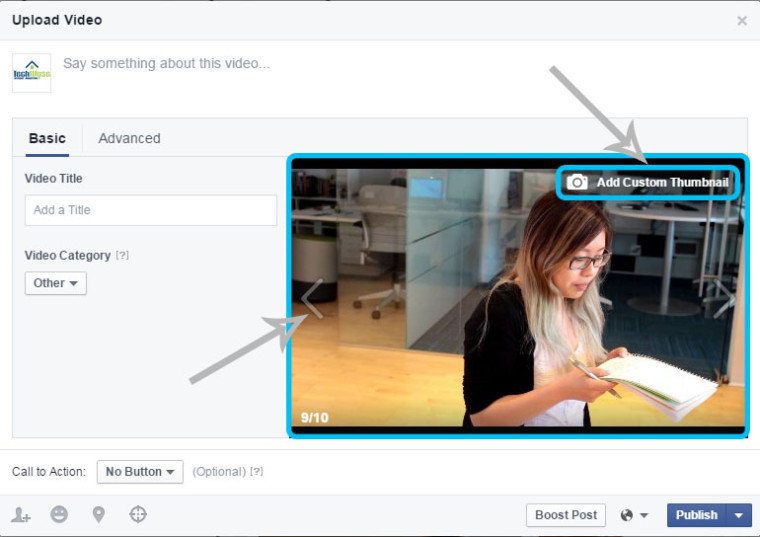
5. Add Overlay Text and/or Captions
Speaking of optimizing for the first three seconds, it’s vital you don’t ignore the power of words even within a visual format like a Facebook video. Why? Before Facebook made auto-play sound the default in February of this year, 85% of Facebook videos were watched without sound. This stat likely hasn’t changed much, either, considering (ironically) Facebook discovered in February of 2016 that 80% of users reacted negatively to auto-play sound in video advertisements specifically.
As such, consider adding overlay text or captions to your videos to see how your audience responds. This word-based strategy ensures users who’ve turned off auto-play sound will still understand what your video is about without having to hear a single peep; in fact, Facebook also discovered in February of last year that captioned video ads increased watch time compared to non-captioned ads by 12%. Essentially, by not annoying your followers, you stand a better chance of them enjoying and sharing the clip. It’s also just polite to include text or captions for hard of hearing Facebook users, and by acknowledging their needs, you’re more likely to see increased watch time from them, as well.
6. Optimize Your Copy
We can’t talk about adding overlay text or captions to your videos without also mentioning the surrounding copy of your videos. Facebook allows page owners to customize a video with text in a few different spots. First is the title, which should be descriptive and searchable while also compelling users to click on it. Second is the preview text, which should summarize what your video is about. And finally, there is the description, which can add more information about your video and encourage users to share or comment on the clip.
When you upload a video to Facebook, make sure you craft the preview text, the description, and the title of your video specific to your audience’s preferences on that platform (not what your viewers on other social media platforms might like). It will take some experimenting to figure out what works best for your brand’s Facebook videos, but Buffer believes shorter copy drives more click-throughs while longer copy generates higher engagement rates. As an example of copy in action, check out how Tasty previews its video about one of its sales:
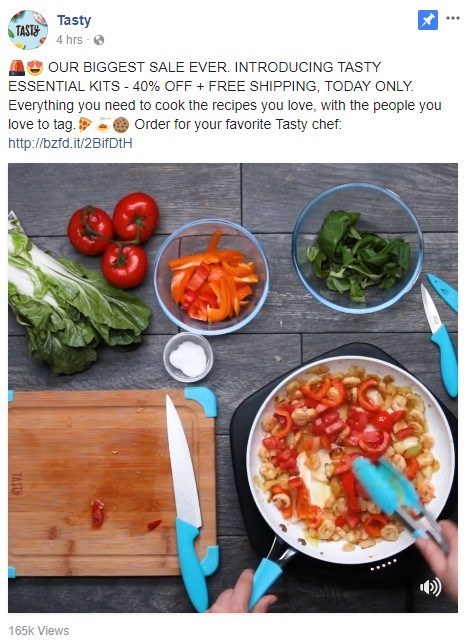
7. Post at the Right Time
Uploading a video to Facebook at a time when it’s most likely to receive views and shares is a simple way to improve your overall watch time. What’s not so simple is figuring out when that ideal upload window is. Multiple studies have shown Saturdays and Sundays generally provide a 32% higher engagement rate on Facebook content, and that most of the site’s users seem to share content more often around 1 p.m. local time.
The best way to determine when you should post your videos on Facebook is to track your analytics. Through these, you should be able to determine patterns as to when your audience most often interacts with your content. See what happens when you post a video during these times, and if you see more shares on your content, you’re on the path to longer watch times.
8. Determine Best Length
In line with the tip we just covered, you should also pay attention to the length of your Facebook videos to see which get the most engagement and shares from your audience. Unfortunately for brands, this can be a tricky balance to strike. Two years ago, we discovered shorter videos tend to perform better in terms of engagement on Facebook. However, a more recent study from Business 2 Community discovered brands are posting longer videos (around 3 minutes and 48 seconds), but at the expense of decreased watch time (only 10 seconds or 4% of the total video).
Again, the easiest way to figure out what length of video your audience likes best is by studying your analytics. Fortunately, Facebook’s backend provides plenty of detail here to help you out, including showing you how long viewers spent watching your videos and how many of them viewed all the way to specific percentage markers (such as 30% as opposed to 95% of the way through the video). Optimizing your video length around this information specific to your audience is vital, especially if you monetize your videos with mid-roll ads which could affect how long users want to stick around to see the rest of your clips.
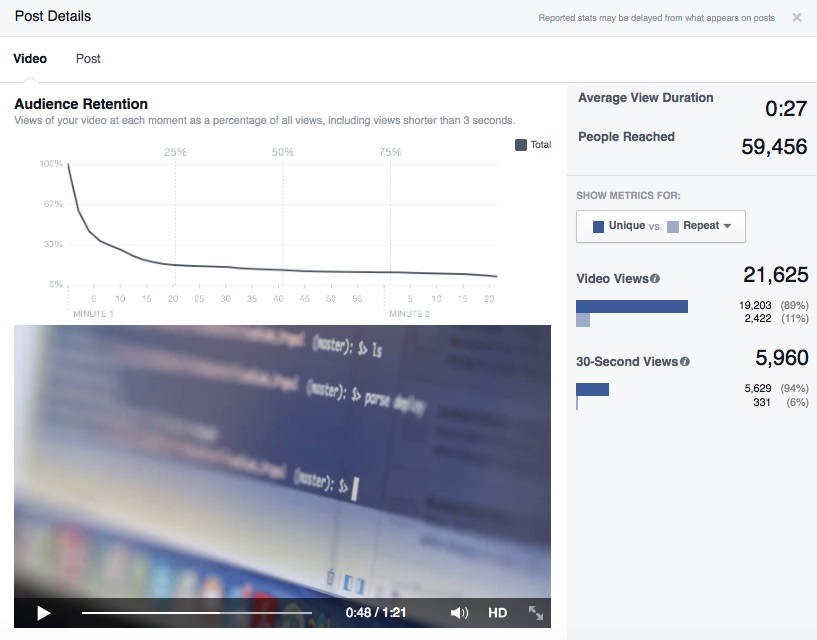
9. Embed Videos on Your Site
This hack for improving your average watch time on Facebook might seem odd, especially since it doesn’t have anything to do with your actual Facebook page itself. But it does directly impact your total watch time, because if you want more eyeballs on your videos, you should consider putting those clips in more places where viewers might stop to watch. The easiest place to do this? Your brand’s website.
By embedding your Facebook videos on your website in blog posts or landing pages, you can improve your overall watch time by catching the attention of site visitors who may not be following your Facebook page. Additionally, you’ll stand a chance of increasing your overall watch time because, thanks to the beauty of Facebook’s video player features, users on your website can watch your embedded Facebook video and share it with friends and family without ever having to leave your site.
10. Stream Live Videos
So far in this article, we’ve talked about ways to increase watch time via shares and engagement on pre-recorded Facebook videos. Now it’s time to turn briefly to live streaming videos, which can also help you get more people watching your content. Many brands are already conducting live streaming sessions, but if yours isn’t one of them, now’s the time to start broadcasting to your Facebook followers.
Using Facebook Live, you’ll be able to generate engagement and shares in real time while also building a more direct relationship with your audience. Live videos are ripe with opportunity for increasing your watch time; Social Media Examiner, for example, discovered that going live more frequently on Facebook generated more exposure and views on its non-live content. And considering the fact that Facebook automatically records and publishes your live streams to your brand’s page, you have a built-in method of attracting more views even after the fact, without having to do any extra work on your backend!
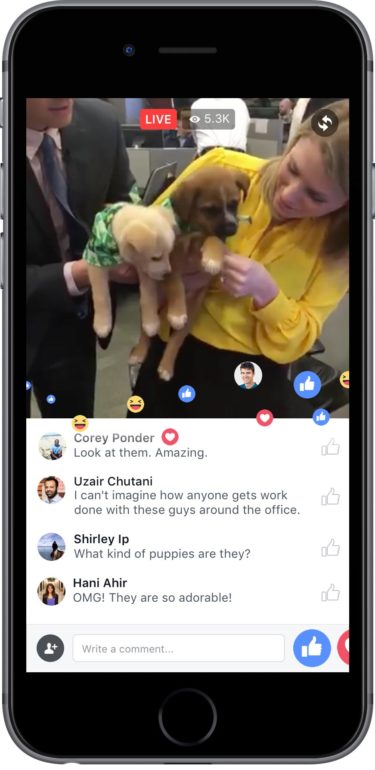
11. Use Tags Liberally (Sort Of)
So far, many of the ways we’ve covered here to help increase watch time make sense, and some brands may even be implementing them already. This new tip, however, isn’t always at the forefront of brands’ minds when it comes to getting more engagement and shares on their Facebook videos, and that is making sure to tag other people and brands in their uploaded video content. The reasoning behind tagging is simple: if you get the attention of other people or brands, they’re more likely to share the clip with their audiences and therefore generate higher watch times.
The key to tagging is making sure every single one is relevant. Tagging a bunch of friends or family members who weren’t involved in the making of the video will look like spam and an ill attempt to get more video views. Instead, focus on tagging people or brands who may have worked with you on the video, inspired the content, or who were mentioned in the video. These tagged entities will receive a notification of your tag, and can then choose to share the clip with their audiences on their own pages or profiles.
12. Specify Both a Featured Video and a Cover Video
Facebook has a nifty tool for pages which allows their owners to specify a featured video to display at the top of the “Videos” section of their pages. When selected, this video will span the width of the “Videos” section and auto-play, which means more potential views and overall watch time on your content. While you’re not likely to get as many engagements or shares on the featured video (since you’re relying on a Facebook user to click on the “Videos” tab from your Facebook page’s home)
Additionally, some brands now have the capability of adding a video as their Facebook page’s cover. If your brand is one of them, this is another opportunity to increase your watch time, as users coming to your Facebook page will automatically see the video playing when they visit. The movement of this video will help attract more eyeballs and could even keep users around on your page longer, resulting in possible engagement and watch time buffs. Here’s the cover video The Next Web uses on their Facebook page:
13. Create Playlists
Facebook saves all of your brand’s uploaded videos under your “Videos” tab for users to access. But if your brand uploads videos on a regular basis, the Videos section can start to look very messy, and users interested in seeing more of your content won’t be able to find what they’re looking for. In order to help your audience navigate your videos, as well as drive more traffic to them overall, make sure you fully utilize the power of playlists.
Playlists allow you compile several videos together in one place, ensuring not just a more organized Facebook page but also the likelihood of users finding more content to watch. You can create different playlists for different topics, shows, or categories your brand routinely produces. Essentially, making the video discovery process easier for your audience increases your chances of them sticking around to watch and engage with more of your content.
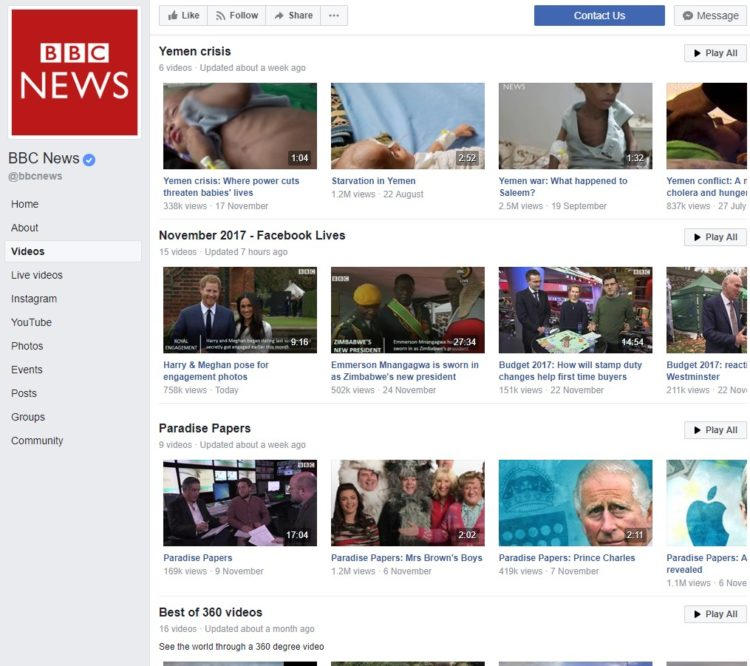
14. Use Ads as Promotion
Another simple way to get more people watching your Facebook videos? Promote specific clips with ads. You can use regular Facebook advertisements or even create a video ad to drive traffic back to the videos you’re trying to promote. This paid strategy will naturally help generate more views on your content, bumping your brand’s total watch time while also extending your reach. You can also choose to simply boost individual video posts to see if this has an impact on your engagement rates and watch time.
The wonderful thing about Facebook ads is how in-depth you can get when targeting your ads. Let’s say you’re a beverage brand interested in promoting a video about your newest flavor of liquor. Your corresponding video ad can be targeted to users who are of legal drinking age, in a certain area of the country, and who have even shown an interest in drinking and mixology via their profiles. You can even choose to have your ad optimized for video views versus engagement; try both to see which focus increases your watch time.
15. Add a Call-to-Action
Finally, we come to the last technique for improving engagement and watch time on your Facebook videos. With every single one of your uploads, make sure to specify a strong call-to-action, which tells viewers directly what you’d like them to do next. A CTA could be some copy in your description or even show up as a mid-roll notification (which Wistia discovered has the highest conversion rates out of all CTAs on videos).
Since the goal of this article was to provide ideas for improving watch time, consider making your call-to-actions a request for users to share your videos with friends and family. If you’ve followed many of the tips in this article already for each of your videos, you have a high chance of users listening to your request and sharing away. Again, every brand’s audience is different, so make sure you pay attention to what kinds of CTAs and requests actually generate a reaction from your viewers and lead you to those higher engagements, shares, and watch times you’re looking for.
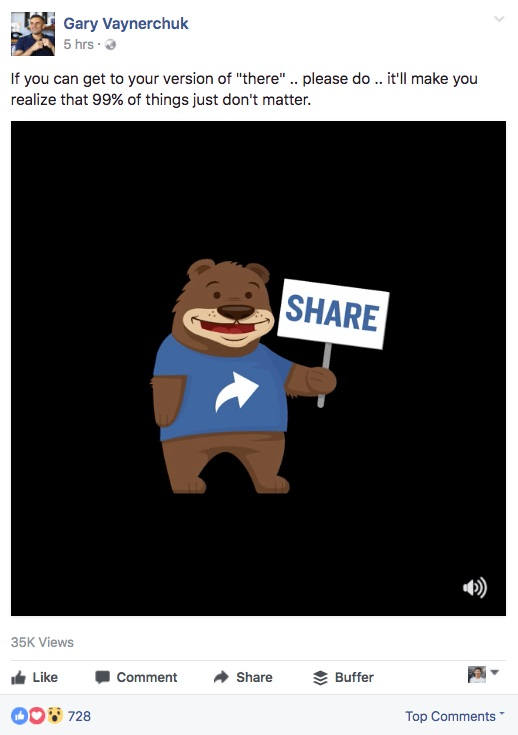
And that’s it! We covered a lot of suggestions for improving your watch time on Facebook videos, so let me make things easier for you and challenge you with this question: what will be your brand’s first step to increase your overall watch time?